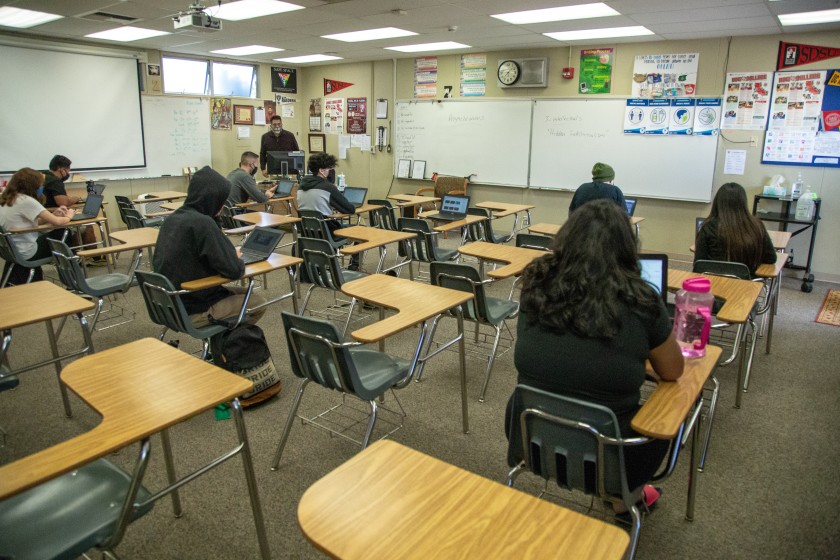
As COVID-19 cases slowly decrease, Bay Area health officials are giving the go-ahead to reopen schools and begin in-class learning for many K-12 students. This has led to controversy. The state guidelines are changing to allow the majority of schools to be reopened, prompting Alameda County Health officials to update their guidelines to align with this reopening. Whether schools reopen or not is ultimately based on the number of a county’s coronavirus cases.
Following a winter surge of cases, and then the recent drop in the months of January and February, the Bay Area overall is either in the red or purple tier, with Alameda County finally moving to the red tier. This means that students in K-6th grade can return to school once their county’s case rate reaches 25 cases per 100,000 people for five consecutive days.
Though many parents throughout the country are adamant about sending their children back to school, many teachers and staff have differing opinions. A majority of teachers that were interviewed about the return are feeling unsafe returning to school without students getting vaccinations to keep them protected from the virus. “I certainly wouldn’t go back to in-person teaching until I get the vaccine, and I think the students should be required to get it as well,” says a Washington High School teacher. “I understand parents wanting their young children to return to in-person education, especially those parents who are struggling to find somebody to watch them, but I don’t think it’s worth the risk of starting another major outbreak. It’s worth noting the vaccines haven’t been approved for children under 12, meaning elementary school teachers will have to teach groups of unvaccinated children.”
Though guidelines are in place, many health experts are weighing in to point out the strategies that are crucial for the safety of both the students and the teachers. CDC Director Dr. Rochelle Walensky stresses the priorities as being the correct use of masks, distancing at least 4 feet from each other, sanitizing, and the use of contact tracing. The safest thing for teachers and staff would be vaccinating and weekly testing for the schools that are reopened or are planning to reopen, according to the CDC.
Two Washington High School teachers, Mr. Glass and Ms. Osicka, weigh in on what precautions should be taken. “Everyone needs PPE. The buildings at school need proper ventilation,” says Ms. Osicka, a teacher in the English department. “We also need guarantees that people will self-quarantine when necessary and not attend school if there is any question of their exposure to COVID-19. My biggest concern is having total trust in our entire community to stick with that promise.”
“Aside from requiring all staff and students old enough to get the vaccine, things like mask requirements and physical distancing should be enforced, says Mr. Glass, a psychology teacher. “It’s hard to imagine having enough room to split every class in half, though, so the distancing would probably require a hybrid model where students are on-site half of the time and at home half of the time.”
Controversy has not only been brought by staff members, but also by students of the various Bay Area school districts. The lingering question remains as to whether it is more beneficial to allow K-6 children back in the classrooms or to begin with the middle school and high school students. Statistics from UCSF Benioff Children’s Hospital have shown that the mental health issues of older children have doubled in the past year of COVID-19 social distancing, and there have also been skyrocketing suicide rates. (If you or anyone you know are suffering from depression and/or suicidal thoughts, please go to https://afsp.org/ for help.)
Middle school students and high school students have also struggled with participation during Zoom classes, leading to worsening grades and report cards full of F’s. The safety guidelines put in place by the state government have brought less and less hope for many older students, leading to pressure being put on politicians and health organizations.
Many older students are hoping to return to school to complete the remainder of their school year, especially students who are seniors. “I don’t mind going back to school and am actually hoping to go back,” says Washington High School senior Sarah Jeung. “I think if we follow guidelines we should be okay.”
According to FUSD Superintendent Cammack’s most recent presentation, the current dates for reopening the schools are as follows: March 29th for preschool, TK-2nd grade, and middle/junior high school; April 13th for 3rd grade-6th grade, and April 19th for high school students.
Amatullah is a senior at Washington. She was born in Oakland, and grew up in Alameda and Fremont. This is her first year at the Hatchet and she loves covering topics involving politics, science, and art. Along with writing, Amatullah loves reading, microscopy, watching sports, and drawing. She volunteers at nonprofits in her free time, is part of the UN Association for Silicon Valley, and tutors children as well. Her future plans are to study in medical programs and join the healthcare field.
